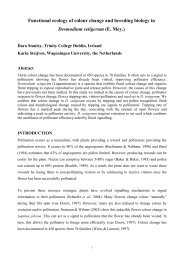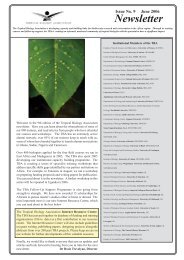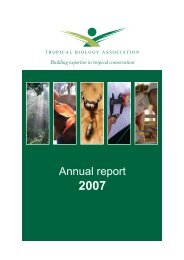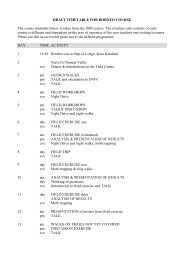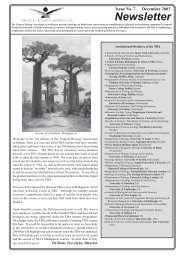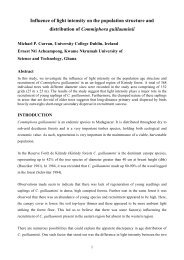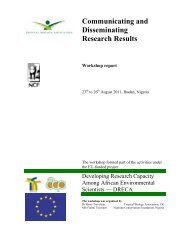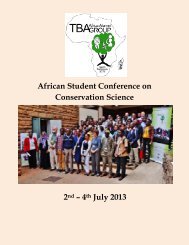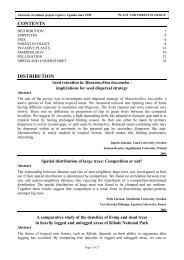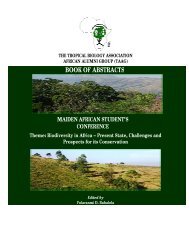Plant and forest ecology - Tropical Biology Association
Plant and forest ecology - Tropical Biology Association
Plant and forest ecology - Tropical Biology Association
Create successful ePaper yourself
Turn your PDF publications into a flip-book with our unique Google optimized e-Paper software.
Abstracts of student project reports: Madagascar courses since 2002<br />
PLANT AND FOREST ECOLOGY<br />
had reasonable samples frequented on average the flowers of 3.3 plant species. These qualitative<br />
results agree with those reported from other temperate <strong>and</strong> tropical systems, in that interactions<br />
appeared to be relatively generalised by pollinator species <strong>and</strong> body plan (e.g., birds vs. bees). Also<br />
in agreement, the visitation web was noticeably nested, with more-specialized species tending to<br />
interact with mutualistic partners that were themselves more generalized. In addition to<br />
documenting previously-unreported interactions, therefore, this preliminary web conforms to more<br />
widespread patterns emerging for pollination systems at the community level.<br />
N. Waser et al. (class exercise)<br />
Structural specialisation <strong>and</strong> pollination <strong>ecology</strong> in two Malagasy species of<br />
Dalechampia (Euphorbiaceae)<br />
Abstract<br />
We compared structural features of the blossoms <strong>and</strong> aspects of pollination <strong>ecology</strong> for the<br />
Madagascan endemic vines Dalechampia bernieri <strong>and</strong> D. subternata, characterised by specialised<br />
<strong>and</strong> generalised pollination, respectively. We measured bract aperture <strong>and</strong> length, visitation rate of<br />
the blossoms <strong>and</strong> the amount of pollen on female flowers. As expected, D. subternata’s bract angle<br />
was stable during the day while D. bernieri’s bract angles changed daily, becoming more widely<br />
open when its specific buzz-pollinating bees were active. Contrary to expectations, D. subternata<br />
flowers were minimally pollinated, while the amount of pollen on D. bernieri’s flowers decreased<br />
when they were visited by specialist pollinators together with more opportunistic ones<br />
2009<br />
Olive Imanizabayo, Dian Fossey Gorilla Fund International, Rw<strong>and</strong>a<br />
Marco Plebani, University of Zurich, Switzerl<strong>and</strong><br />
2012<br />
.<br />
Page 11 of 11




